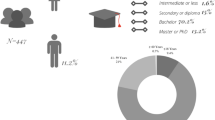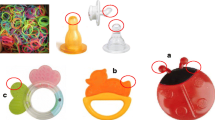Abstract
Specialized cosmetic products for infant use are gaining a lot of popularity in the Indian as well as global market, as these products have become an inseparable part of modern urban lifestyle. Baby cosmetics are available in a wide range. They claim to be milder than similar products meant for adult use. However, these products need to be checked for their safety through a battery of assays based on biological systems, along with the ones based on chemical and physical protocols. This study attempts to test different baby cosmetic products using one prokaryotic and one eukaryotic assay system. Chemical protocols prescribed by cosmetic product controlling organizations of India are also used to estimate the quantity of harmful heavy metals like arsenic, lead and cadmium if present in the samples. Few of the products tested have shown significant toxicity as well as heavy metal content. The results hold a lot of importance keeping in mind the extra sensitivity of an infant body. It is further suggested that studies using cell based and in vivo test systems should be done to confirm the findings.



Similar content being viewed by others
References
Bitton G, Koopman B, Wang HD (1984) Baker’s yeast assay procedure for testing heavy metal toxicity. Bull Environ Contam Toxicol 32:80–84
Bocca B, Pino A, Alimonti A, Forte G (2014) Toxic metals contained in cosmetics: a status report. Regul Toxicol Pharmacol 68:447–467
Brod BA, Treat JR, Rothe MJ, Jacob SE (2015) Allergic contact dermatitis: kids are not just little people. Clin Dermatol 33(6):605–612
Degouy A, Gomez-Berrada M, Ferret P (2014) Baby care product development: artificial urine in vitro assay is useful for cosmetic product assessment. Toxicol In Vitro 28(1):3–7
Diaz JH (2016) Chemical and plant-based insect repellents: efficacy, safety, and toxicity. Wilderness Environ Med 27(1):153–163
Dutka BJ, Kwan KK (1981) Comparison of three microbial toxicity screening tests with the Microtox test. Bull Environ Contam Toxicol 27:753–757
Fruijtier-Pölloth C (2005) Safety assessment on polyethylene glycols (PEGs) and their derivatives as used in cosmetic products. Toxicology 214(1–2):1–38
Gocke E, King M-T, Eckhardt K, Wild D (1981) Mutagenicity of cosmetics ingredients licensed by the European Communities. Mutat Res Genet Toxicol 90(2):91–109
Gomez-Berrada MP, Ficheux AS, Dahmoul Z, Roudot AC, Ferret PJ (2017) Exposure assessment of family cosmetic products dedicated to babies, children and adults. Food Chem Toxicol 103:56–65
Ke YJ, Qin XD, Zhang YC, Li H, Li R, Yuan JL, Yang X, Ding SM (2014) In vitro study on cytotoxicity and intracellular formaldehyde concentration changes after exposure to formaldehyde and its derivatives. Hum Exp Toxicol 33(8):822–830
Kim S, Choi K (2014) Occurrences, toxicities, and ecological risks of benzophenone-3, a common component of organic sunscreen products: a mini-review. Environ Int 70:143–157
Kirchoff MG, Gannes GCD (2013) The health controversies of parabens. Skin Therapy Lett 18(2):5–7
Lessmann H, Uter W, Schnuch A, Geier J (2009) Skin sensitizing properties of the ethanolamines mono-, di-, and triethanolamine. Data analysis of a multicentre surveillance network (IVDK*) and review of the literature. Contact Dermat 60(5):243–255
Li H, Lydy MJ, You J (2016) Pyrethroids in indoor air during application of various mosquito repellents: occurrence, dissipation and potential exposure risk. Chemosphere 144:2427–2435
Lovschall H, Eiskjaer M, Arenholt-Bindslev D (2002) Formaldehyde cytotoxicity in three human cell types assessed in three different assays. Toxicol In Vitro 16(1):63–69
Lv C, Hou J, Xie W, Cheng H (2015) Investigation on formaldehyde release from preservatives in cosmetics. Int J Cosmet Sci 37:474–478
McManus KJ (2014) Update on newborn bathing. Newborn Infant Nurs Rev 14(4):166–170
Paz M, Muzio H, Mendelson A, Magdaleno A, Tornello C, Balbis N, Moretton J (2006) Evaluation of genotoxicity and toxicity of Buenos Aires city hospital wastewater samples. J Braz Soc Ecotoxicol 1(1):1–6
Rogiers V (2015) Quantitative risk assessment in the EU of cosmetics for babies and children. Toxicol Lett 238(2):S51
Roy DN, Goswami R, Pal A (2017) The insect repellents: a silent environmental chemical toxicant to the health. Environ Toxicol Pharmacol 50:91–102
Sharma P, Mathur N, Singh A, Bhatnagar P (2014) An imperative study on toxicological evaluation of hospital wastewaters. Asian J Sci Technol 5:674–677
Tchounwou PB, Yedjou CG, Patlolla AK, Sutton DJ (2012) Heavy metals toxicity and the environment. Mol Clin Environ Toxicol 101:133–164
Visscher M, Narendran V (2014) Neonatal infant skin: development, structure and function. Newborn Infant Nurs Rev 14(4):135–141
WHO (2006) Ethylbutylacetylaminopropionate, WHO specifications and evaluations for public health pesticides, pp 1–25. http://www.who.int/whopes/quality/en/IR3535_eval_april_2006.pdf?ua=1
Yoshida I, Ibuki Y (2014) Formaldehyde-induced histone H3 phosphorylation via JNK and the expression of proto-oncogenes. Mutat Res, Fundam Mol Mech Mutagen 770:9–18
Acknowledgements
The authors thank Dr. Rashmi Sisodia, Department head, Department of Zoology for providing complete support during the study. We also thank Jagdamba Laboratories Pvt. Ltd. for helping with the heavy metal estimation techniques.
Author information
Authors and Affiliations
Corresponding author
Additional information
Editorial responsibility: Tanmoy Karak
Electronic supplementary material
Below is the link to the electronic supplementary material.
Rights and permissions
About this article
Cite this article
Nepalia, A., Singh, A., Mathur, N. et al. Toxicity assessment of popular baby skin care products from Indian market using microbial bioassays and chemical methods. Int. J. Environ. Sci. Technol. 15, 2317–2324 (2018). https://doi.org/10.1007/s13762-017-1556-z
Received:
Revised:
Accepted:
Published:
Issue Date:
DOI: https://doi.org/10.1007/s13762-017-1556-z




